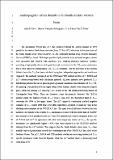Por favor, use este identificador para citar o enlazar a este item:
http://hdl.handle.net/10261/48760COMPARTIR / EXPORTAR:
 SHARE SHARE
 CORE
BASE CORE
BASE
|
|
| Visualizar otros formatos: MARC | Dublin Core | RDF | ORE | MODS | METS | DIDL | DATACITE | |

| Título: | Anthropogenic carbon dioxide in the South Atlantic western basin |
Autor: | Ríos, Aida F. CSIC; Vázquez Rodríguez, Marcos CSIC; Padín, X. A. CSIC ORCID; Pérez, Fiz F. CSIC ORCID | Palabras clave: | Anthropogenic CO2 Back-calculation Carbon storage Water masses South Atlantic Ocean |
Fecha de publicación: | 2010 | Editor: | Elsevier | Citación: | Journal of Marine Systems 83(1-2): 38-44 (2010) | Resumen: | The meridional WOCE line A17 was conducted during the austral summer of 1994 parallel to the eastern South American coast, from 55°S to 10°S, where one of the main limbs of the North Atlantic Deep Water (NADW), i.e., the southward-flowing Deep Western Boundary Current (DWBC) is found. Full-depth profiles of pH, total alkalinity and total inorganic carbon were measured and checked with analytical CO2 certified reference materials (CRMs), providing a high-quality dataset with good internal consistency for the CO2 system parameters that is well suited for anthropogenic CO2 (CANT) estimation. For the first time in the westernAtlantic basin the CANT has been calculated using four independent approaches and results are compared. The methods considered are the CFC-based TTD method and the φCT°, TrOCA and ∆C* carbon system-based back-calculation methods. All four methods have produced CANT distribution patterns that are in general good agreement: maximum concentrations of CANT (50–60 μmol kg− 1) are predicted for the upper warm SouthAtlantic central waters from the tropical gyres, while the minima (~ 5 μmol kg− 1) are located in the old northward-flowing branch of Circumpolar Deep Water. There are, however, some discrepancies detected. The TrOCA method yields the highest overall [CANT] values, even over the theoretical limit of CANT saturation for 1994 in the upper layers. The ∆C* approach consistently yielded negative estimates of CANT below 2800 dbar, even after correcting a reported − 8 μmol kg− 1 bias in the alkalinity measurements of the WOCE A17 line. The main overall difference between the four methods corresponds to the relative CANT maximum associated with the lower limb of NADW: this structure is well identified in the φCT° and TTD methods but seems to disappear in the case of TrOCA and ∆C*. In agreement with other intercomparison studies of CANT, the specific inventories are significantly higher (~ 45%) than those reported in the GLODAP database obtained from the ΔC* method. This suggests that the SouthAtlantic stores more CANT than initially expected, particularly towards the southernmost tip of the WOCE A17 line, close to the Southern Ocean. The φCT°, TrOCA and TTD methods confirm an increasing tendency of CANT specific inventories south from the Equator, while the ΔC* method shows a decreasing trend south from 35°S | Descripción: | 23 páginas, 4 figuras | Versión del editor: | http://dx.doi.org/10.1016/j.jmarsys.2010.06.010 | URI: | http://hdl.handle.net/10261/48760 | DOI: | 10.1016/j.jmarsys.2010.06.010 | ISSN: | 0924-7963 | E-ISSN: | 1879-1573 |
| Aparece en las colecciones: | (IIM) Artículos |
Ficheros en este ítem:
| Fichero | Descripción | Tamaño | Formato | |
|---|---|---|---|---|
| Cant in the SA western basin _online colour version_.pdf | 834,49 kB | Adobe PDF |  Visualizar/Abrir |
CORE Recommender
SCOPUSTM
Citations
18
checked on 20-abr-2024
WEB OF SCIENCETM
Citations
18
checked on 26-feb-2024
Page view(s)
344
checked on 24-abr-2024
Download(s)
325
checked on 24-abr-2024
Google ScholarTM
Check
Altmetric
Altmetric
NOTA: Los ítems de Digital.CSIC están protegidos por copyright, con todos los derechos reservados, a menos que se indique lo contrario.
